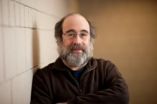(Press-News.org) CAMBRIDGE, Mass. -- While the primary job of DNA in cells is to carry genetic information from one generation to the next, some scientists also see the highly stable and programmable molecule as an ideal building material for nanoscale structures that could be used to deliver drugs, act as biosensors, perform artificial photosynthesis and more.
Trying to build DNA structures on a large scale was once considered unthinkable. But about five years ago, Caltech computational bioengineer Paul Rothemund laid out a new design strategy called DNA origami: the construction of two-dimensional shapes from a DNA strand folded over on itself and secured by short "staple" strands. Several years later, William Shih's lab at Harvard Medical School translated this concept to three dimensions, allowing design of complex curved and bent structures that opened new avenues for synthetic biological design at the nanoscale.
A major hurdle to these increasingly complex designs has been automation of the design process. Now a team at MIT, led by biological engineer Mark Bathe, has developed software that makes it easier to predict the three-dimensional shape that will result from a given DNA template. While the software doesn't fully automate the design process, it makes it considerably easier for designers to create complex 3-D structures, controlling their flexibility and potentially their folding stability.
"We ultimately seek a design tool where you can start with a picture of the complex three-dimensional shape of interest, and the algorithm searches for optimal sequence combinations," says Bathe, the Samuel A. Goldblith Assistant Professor of Applied Biology. "In order to make this technology for nanoassembly available to the broader community — including biologists, chemists, and materials scientists without expertise in the DNA origami technique — the computational tool needs to be fully automated, with a minimum of human input or intervention."
Bathe and his colleagues described their new software in the Feb. 25 issue of Nature Methods. In that paper, they also provide a primer on creating DNA origami with collaborator Hendrik Dietz at the Technische Universitaet Muenchen. "One bottleneck for making the technology more broadly useful is that only a small group of specialized researchers are trained in scaffolded DNA origami design," Bathe says.
DNA consists of a string of four nucleotide bases known as A, T, G and C, which make the molecule easy to program. According to nature's rules, A binds only with T, and G only with C. "With DNA, at the small scale, you can program these sequences to self-assemble and fold into a very specific final structure, with separate strands brought together to make larger-scale objects," Bathe says.
Rothemund's origami design strategy is based on the idea of getting a long strand of DNA to fold in two dimensions, as if laid on a flat surface. In his first paper outlining the method, he used a viral genome consisting of approximately 8,000 nucleotides to create 2-D stars, triangles and smiley faces.
That single strand of DNA serves as a "scaffold" for the rest of the structure. Hundreds of shorter strands, each about 20 to 40 bases in length, combine with the scaffold to hold it in its final, folded shape.
"DNA is in many ways better suited to self-assembly than proteins, whose physical properties are both difficult to control and sensitive to their environment," Bathe says.
Bathe's new software program interfaces with a software program from Shih's lab called caDNAno, which allows users to manually create scaffolded DNA origami from a two-dimensional layout. The new program, dubbed CanDo, takes caDNAno's 2-D blueprint and predicts the ultimate 3-D shape of the design. This resulting shape is often unintuitive, Bathe says, because DNA is a flexible object that twists, bends and stretches as it folds to form a complex 3-D shape.
INFORMATION:
Written by Anne Trafton, MIT News Office
END
Twenty-four hour cycles, known as circadian rhythms, are important for proper body functions, including for normal brain function and mental health. Disruptions of circadian rhythms and sleep-wake cycles have been observed in patients with Alzheimer's disease. A new study by Douglas Institute researchers unravels a possible basis for these perturbations.
First study to show function of clock genes in multiple areas of the human brain
Until now, the genes contributing to this timing, known as clock genes, have only been found to be active in areas outside the brain, such ...
ANN ARBOR, Mich. — Researchers at the University of Michigan Comprehensive Cancer Center have identified a protein that shows distinct changes in structure between pancreatic cancer, non-cancerous diseases and normal blood serum. The protein also changes from early stage pancreatic cancer to advanced disease.
The finding suggests a blood test could serve as a potential screening tool to detect pancreatic cancer – which has the worst prognosis of any cancer type – at an earlier, more treatable stage.
"One of the difficulties in screening for pancreatic cancer is distinguishing ...
British Airways has increased capacity on its popular London City to Palma service by 50 per cent to meet the demand for seats this summer.
With additional frequency and larger aircraft the airline will be providing over 25,000 seats to the Spanish holiday island direct from the Docklands making holidays to Palma de Mallorca more accessible than ever before.
Due to the high early season demand, the three-times-a-week flights will increase to six-days-a-week, excluding Saturdays, in July and August. The Friday and Sunday flights to Palma de Mallorca and Ibiza, on ...
University of Alberta-led research has confirmed that a relatively harmless inorganic form of mercury found worldwide in ocean water is transformed into a potent neurotoxin in the seawater itself.
After two years of testing water samples across the Arctic Ocean, the researchers found that relatively harmless inorganic mercury, released from human activities like industry and coal burning, undergoes a process called methylation and becomes deadly monomethylmercury.
Unlike inorganic mercury, monomethylmercury is bio-accumulative, meaning its toxic effects are amplified ...
Guoman Hotels Grand Imperial London has launched its unique take on a timeless classic by offering its customers Oriental Afternoon Tea.
Recalling the glamour of the orient with a sleek modern twist, guests can unwind safe in the knowledge that even their 'chi' will get some much needed rejuvenation in an ambience designed with a Feng Shui master.
The Asian-inspired tea arrives presented on a stand laden with Cantonese sweets, treats and savouries. The first course includes fresh black cod rolls, wrapped in Kataifi pastry and Char Sui Bao. Both made with the freshest ...
Edmonton – Researchers in the Faculty of Medicine & Dentistry at the University of Alberta have made an important discovery that provides a new understanding of how our immune system "learns" not to attack our own body, and this could affect the way doctors treat patients with autoimmune diseases and cancer.
When patients undergo chemotherapy for cancer or as part of experimental therapies to treat autoimmune diseases such as diabetes and lupus, the treatment kills the patients' white blood cells. What can be done afterwards, is to give these patients blood stem cells ...
Berkeley, CA-- As China's economy continues to soar, its energy use and greenhouse gas emissions will keep on soaring as well—or so goes the conventional wisdom. A new analysis by researchers at Lawrence Berkeley National Laboratory (Berkeley Lab) now is challenging that notion, one widely held in both the United States and China.
Well before mid-century, according to a new study by Berkeley Lab's China Energy Group, that nation's energy use will level off, even as its population edges past 1.4 billion. "I think this is very good news,'' says Mark Levine, co-author of ...
Researchers have begun screening the first definitive collection of thousands of approved drugs for clinical use against rare and neglected diseases. They are hunting for additional uses of the drugs hoping to find off-label therapies, for some of the 6,000 rare diseases that afflict 25 million Americans. The effort is coordinated by the National Institutes of Health's Chemical Genomics Center (NCGC).
"This is a critical step to explore the full potential of these drugs for new applications," said NIH Director Francis S. Collins, M.D., Ph.D. "The hope is that this process ...
Fasthosts Internet Ltd, a leading web hosting provider, has announced a brand new mobile website builder for its hosting customers. The service enables any level of user to build a mobile compatible website in minutes.
The mobile website builder application can detect mobile visitors and provides them the choice of whether to view a mobile-friendly website or full website version. By catering for mobile users, a business can tap into additional online revenues and ensure greater customer retention and recommendation.
More Britons are browsing the web on the ...
A new study in rats is shedding light on how sleep-deprived lifestyles might impair functioning without people realizing it. The more rats are sleep-deprived, the more some of their neurons take catnaps – with consequent declines in task performance. Even though the animals are awake and active, brainwave measures reveal that scattered groups of neurons in the thinking part of their brain, or cortex, are briefly falling asleep, scientists funded by the National Institutes of Health have discovered.
"Such tired neurons in an awake brain may be responsible for the attention ...

